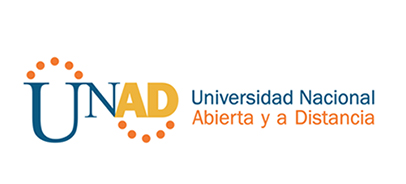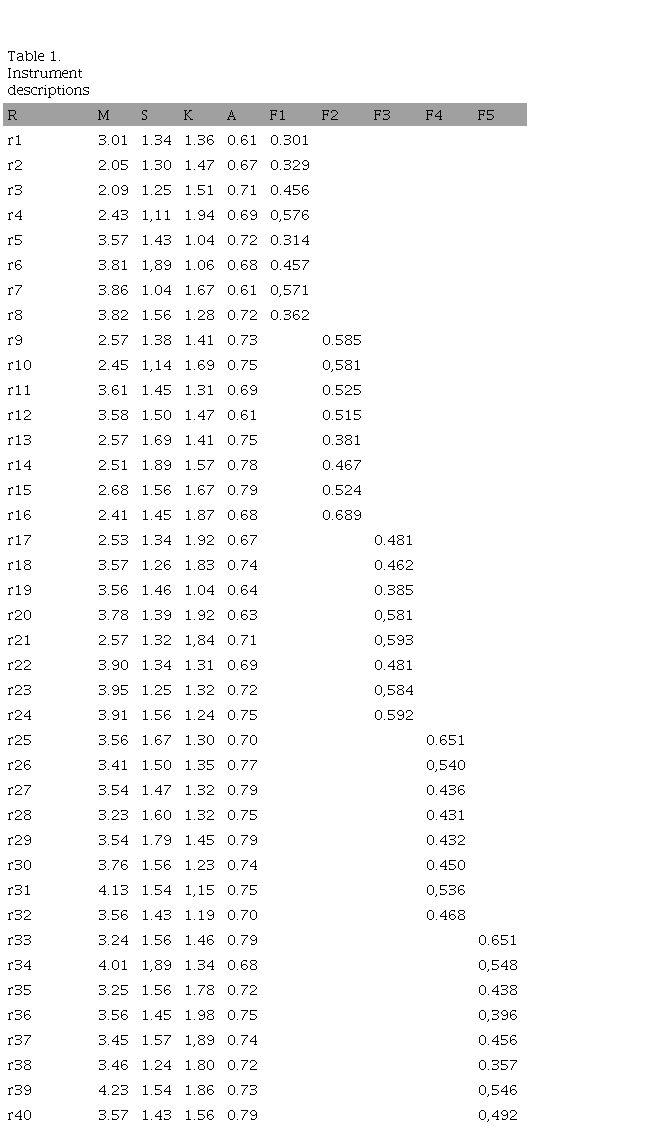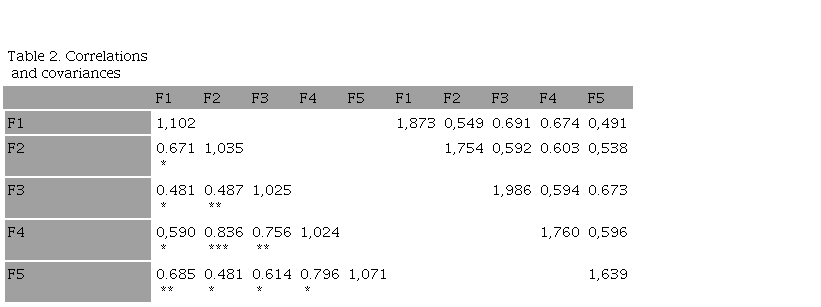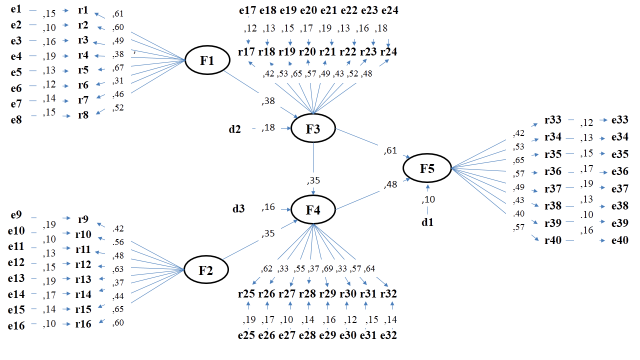

EMPRENDIMIENTO CAFETERO DURANTE COVID-19
Coffee entrepreneurship during COVID-19
Publicaciones e Investigación, vol.. 14, no. 1, 2020
Universidad Nacional Abierta y a Distancia


Artículo original
Received: 07 April 2020
Accepted: 30 April 2020
Resumen: –La exploración de las relaciones entre los determinantes del emprendimiento fue el objetivo de este trabajo. Se llevó a cabo un estudio no experimental con una selección no probabilística de 300 productores de café afiliados al programa de microfinanzas. Se observa una estructura de cinco factores: representaciones, habitus, campos, capital, capacidades y empresa que explicaron el 54% de la varianza total explicada, aunque el estudio de investigación limitó los hallazgos del escenario local, sugiriendo la inclusión de variables que la literatura identifica sociodemográficas y socioeconómicas. Variables para establecer perfiles empresariales de acuerdo con eventos de riesgo; deslizamientos, incendios, sequías, inundaciones, heladas o terremotos.
Palabras clave: –Crecimiento del café, emprendimiento, jefes de familia, modelo, microempresa.
Abstract: –The exploration of the relationships between the determinants of entrepreneurship was the objective of this work. A non-experimental study was carried out with a non-probabilistic selection of 300 coffee farmers affiliated to the microfinance program. Is observed a structure of five factors: representations, habitus, fields, capital, capabilities and enterprise that explained 54% of the total variance explained, although the research design limited findings local scenario, suggesting the inclusion of variables that the literature identifies sociodemographic and socioeconomic variables to establish entrepreneurial profiles according to risk events; landslides, fires, droughts, floods, frosts or earthquakes.
Keywords: –Coffee growing, entrepreneurship, heads of family, model, microenterprise.
1. INTRODUCTION
As of this writing, the SARS-COV-2 coronavirus and COVID-19 disease have led to 11 million infection, 6 million disease, and 700,000 deaths globally. In Mexico, 250,000 have been infected, 60,000 become ill and 30,000 have died.
In this disaster scenario, the communities have generated an enterprise that is distinguished by; I) the alliance between local governments with migratory and native flows, II) the financing of projects with seed capital of remittances and micro financing, III) the diversification of the product based on mountain tourism (Segura Mojica, 2020).
However, this process has been interrupted due to the management of sanitary, economic and environmental risks at the local, state and federal levels, among which stand out; 1) cut funding for projects, 2) minimal discretionary support based on the opacity of a registry, 3) relationships of trust between authorities and coffee growers limited by the availability of resources.
Precisely, the objective of this work lies in the specification of a model for the study of the habitus representations and capacities of coffee growers around the effects of the sanitary, economic and environmental crisis on the diversification and commercialization of coffee in mountain tourism. once the lack of confidence is carried out and social entrepreneurship emerges.
The hypothesis that answers the question about representation, habitus and entrepreneurship in the face of the effects of COVID-19 is that microfinance and remittances can support projects if they diversify into attractive products for ecotourists once the confinement has been overcome. Such diversification supposes perceptions bordering on the aesthetics of the locality (aesthesis), the expressiveness (hexis) of the migrants, the ethics (ethos) of the natives and the knowledge (eidos) of the promoters.
Thus, the present work includes sections and contributions for the analysis of the phenomenon, considering: a) entrepreneurship theory in which the approximations of representations, habitus, fields and capitals are discussed; b) studies of social entrepreneurship highlighting the categories of analysis, their measurement as variables and relationship trajectories; c) modeling of these variables in order to explain theoretically and conceptually social entrepreneurship; d) methodological approach for the systematic observation of the problem; e) discussion of the findings with the state of the art and f) proposal for a public policy design for microfinance.
2. THEORY OF SOCIAL ENTREPRENEURSHIP
In the context of the confinement of people due to a pandemic, the emergence of social processes such as representations, habitus, capitals, fields and capacities has been systematically observed by the social sciences. These are responses to a problem that may be global, but with local repercussions. In this section, the levels of these community processes are examined and discussed in order to be able to explain the problem in a general way.
The theoretical and conceptual frameworks that explain entrepreneurship as a local response to a risk event such as a health crisis, economic recession and environmental impact suggest that such a phenomenon can be observed from the representations of natives and migrants of its resources. It is about the historical construction of experiences in a crisis like an epidemic (Berrou and Combaunous, 2012). Or, simple perceptions of risk in isolated cases of contagion, disease and death.
The theoretical and conceptual frameworks that explain entrepreneurship as a local response to a risk event such as a health crisis, economic recession and environmental impact suggest that such a phenomenon can be observed from the representations of natives and migrants of its resources (Carreón, 2016). It is about the historical construction of experiences in a crisis like an epidemic. Or, simple perceptions of risk in isolated cases of contagion, disease and death.
Habitus theory tries to compensate for this predictive gap in social representations by assuming that natives and migrants, coffee growers and merchants, tourists and residents develop provisions against or in favor of a situation (Fuentes and Sánchez, 2010). This is the case of the prestige of a community, the reputation of gastronomy or the image of ceremonial destinations. This approach highlights four elements that would explain the emergence of entrepreneurship as an image of destiny (aesthesis), a principle of service (ethos), deep knowledge (eidos) and traditional expressiveness (hexis).
So, it means that entrepreneurship from the habitus perspective is a symbolic liberation of cities and that competitive advantage is identified by tourists who associate the place with the consumption of coffee and its derivatives (García Lirios, 2017). Associations between natives and migrants that shape cooperative societies underlie this representation and habitus of entrepreneurship. This formation of social capital assumes that the parties involved prefer to carry out joint actions if the benefits outweigh the risks.
The theory of social capital considers entrepreneurship as a result of the symbolic liberation of a peripheral community with a governing center, but unlike representations and habitus, its importance lies in the explanation of an undertaking consistent with the availability of resources (Gómez Gómez, Baquero Soler, & Álvarez Zapata, 2019). While social representations can mean scarcity or abundance, unhealthy or wholesome, expensive or cheaper, and habitus can focus their attention on the comparative advantages of the locality, the vision of social capital assumes a balance between demands and resources in the face of any event of risk.
In summary, the representations (risks and benefits of a locality). habitus (aesthetics, expressivity, knowledge and ethics of a community) and capitals (demands and resources in balance) are symbolic theoretical and conceptual perspectives (López Lemus & De la Garza Carranza, 2019). In other words, trying to account for slavery and the liberation of a group and its environment before a dominant governing axis.
On a less symbolic level, field theory highlights power structures and discourses that seek to limit the freedoms and resources of the parties involved in the venture (Loui, Carpio and Vergara, 2012). Consequently, it refers to scenarios that can be transformed into narratives of failure or success in the face of risky events. They are places of influence where the same venture be a resource of natives or migrants, residents or tourists, workers and entrepreneurs.
The importance of the fields of power and influence lies in the fact that the capacities or strategies of change and potential liberation actions are gestated not only symbolically as the representations and habitus intend, but also, as a practice, be discursive, sequential or executory (Obrego, 2008). If the fields are a repertoire of opportunities, the capacities are a self-management mechanism for proposals and innovations.
In summary, it is possible to notice that entrepreneurship is explained by symbolic dimensions of representation, habitus and capital, but they are also concrete dimensions of fields of power and instrumental capacities. In a risk event such as a sanitary, economic and environmental crisis, the exposed theoretical frameworks anticipate the local undertaking in response to a global problem.
3. STUDIES OF SOCIAL ENTREPRENEURSHIP
The events of risk, health crises such as pandemics, economic crises such as misery and unemployment, as well as environmental crises such as frosts, earthquakes, floods, droughts, plagues or hurricanes are ideal scenarios for the emergence of entrepreneurship in its dimensions of representation, habitus , capitals, fields and capacities. This section presents the most recent studies on these dimensions of entrepreneurship in order to be able to model in a consecutive section the trajectories of relationships between the variables.
Often, the classical literature on entrepreneurship divides its observation of this phenomenon into two dimensions: optimization of resources and process innovation. From both models, the two variables configure structures resulting from risk events (Hamrouni Dakoumi & Abdelwahed, 2014). Unlike the opportunism that supposes a favorable situation for the entrepreneur, the risk events are scenes of scarcity, shortages, unhealthiness and shortage. In this sense, research on optimization and innovation contributed to understanding the gestation of the phenomenon in contingencies.
However, the two dimensions very soon diversified to explain in more detail the symbolic and concrete aspects of the undertaking (Carr & Sequeira, 2007). This was so because optimization and innovation were not always concomitant in imminent risk events such as hurricanes or droughts. It is known that in earthquakes resource optimization correlates with process innovation, but this is not the case in floods where the loss of resources increases while the innovations are not generated.
In this way, the symbolic studies of entrepreneurship very soon observed the social representations of a risk event, contingent situation or uncertain scenario (Rodríguez Ramírez, 2009). Thus, the instruments that measured the phenomenon focused on perceptions of risk and benefit. In these works, the associations between perceived risks with process optimization and expected profits with process innovation stand out.
Very soon, the contributions from the dimensions of the habitus allowed to observe symbolic structures of power and influence among entrepreneurs when risks and profits were related to aesthetic, ethical, logical and expressive dispositions (Zapata Domíngez, Corredor Gómez & Mena de la Cruz, 2019). In the cases of fires, floods, frosts or pests, the affectation to nature generates aesthetic dispositions that are associated with the subsequent optimization of resources, but very spuriously with process innovation. It is in earthquakes where technology correlates with aesthetic and expressive habitus.
However, in the management of resources for their optimization or innovation, a variable identified as symbolic capitals was observed (García-Macias, Zerón-Félix & Sánchez-Tovar, 2018). During a negotiation, agreement or co-responsibility, the trust between the parties acquires a consolidated status when both identify in their counterpart a capital of power and influence.
At that level of trust and commitment, a symbolic capital is one that is distinguished by its collaboration in situations of risk or contingent scenarios (Sarabia Huerta & Delhumeau Rivera, 2019). The degree of uncertainty generated by an environmental crisis favors the creation of cooperative pairs and with it the adoption of technology. This same relationship is observed with the specific dimensions of entrepreneurship for fields and capacities. In other words, collaboration consolidates monopolies or fields of power, but also management capacities.
In summary, the optimization of resources and the innovation of processes as indicators of entrepreneurship in unfavorable or favorable situations have been associated with symbolic (representations, habitus and capital) and concrete components (fields and capacities). In risk events, these correlations have been observed, but not systematized in explanatory and predictive models.
4. MODELLING OF SOCIAL ENTREPRENEURSHIP
So far, theoretical, conceptual and empirical frameworks have explained social entrepreneurship as a result of an unfavorable or favorable situation but have not built a comprehensive model from which the effects of a risk event such as the health crisis, recession are anticipated. economic and environmental risks. This chapter includes the hypotheses regarding the contrast of the findings reported in the literature with respect to those observed.
A model includes the axes, trajectories and relationships between variables and indicators in order to explain a complex phenomenon such as entrepreneurship in a critical situation such as the pandemic. In this sense, theories and studies support associations between variables according to their symbolic dimension, such as representations, habitus, and capital, or concrete, such as fields and capacities.
From this distinction, it is possible to notice that the representations and habitus, being more symbolic, determine concrete actions such as capacities, but this process would be regulated by fields and capitals, since both refer to the discussion, agreement and co-responsibility of power and the influence between the sintered parts. In this way, the surrounding information in the media on the health, economic and environmental crises impact on the representations and habitus to be filtered by the fields and the capitals. Such mediation reduces or increases the impact of pandemic figures, images, or phrases on opportunity management capabilities.
5. METHOD
A cross-sectional and correlational study was carried out. A non-probabilistic selection of 300 merchants was carried out, the selection criterion being that they had been migrants.
The Multifactorial Scale of Worker, Entrepreneurial and Transforming Spirit was built, which includes 4 0 items related to representations, habitus, fields, capitals and capacities in their dimensions of objectification, anchoring, inheritance, apprehension, freedoms, opportunities, responsibilities, cooperation, solidarity, values, skills and knowledge.
An analysis of normal distribution, reliability, validity, covariance, structure and fit was carried out.
Normality. From the kurtosis parameter in which the values close to the unit denote a distribution in the form of a normal curve, the requirement for the estimation of other parameters and analysis was established. In addition, the level of significance was calculated with the Boostrap statistic whose value should have been significant at 0,000.
Reliability. We proceeded to establish the internal consistency between items and scale or subscales with the help of Cronbach's alpha in which values higher than 0.60 were considered as evidence of reliable results in different contexts, latitudes or samples. On the other hand, values close to zero were assumed as evidence of a spurious relationship between the item and the subscale, as well as values close to unity as evidence of collinearity or multicollinearity between the reactants and the scale.
Validity. The correlation between factors and items was carried out with the help of above 0,300 factor weights prior exploratory factor analysis and j is rotating main pro max, adaptation and sphericity. The chi-square statistics close to the unit were assumed as evidence of sphericity according to Bartlett's test and values higher than 6.0 were assumed as evidence of adequacy, according to Kayser Meyer Olkin's test.
Covariation. To establish correlations between the factors, phi parameters were used in which values close to zero were considered as spurious, while those close to the unit were assumed as collinear.
Structuring. With the help of the phi, beta and epsilon parameters, we proceeded to calculate the structural model in which those values close to zero were assumed as spurious while those close to the unit were considered as collinear.
Adjustment. In the case of the explained variance percentages, values higher than 0.20 were considered as adjustment evidence, while the chi square value for hypothesis testing was assumed to be close to zero evidence of an adjustment. Because the size of the sample has an impact on the chi-squared values, the goodness-of-fit indices were estimated in which values close to the unit were considered as evidence of adjustment, while those close to zero for residual rates They were also considered as a good fit.
6. RESULTS
Prior to the multivariate analysis, the normal distribution of the responses to the instrument that measured the enterprise and its corresponding dimensions of representations, habitus, fields, capitals and capacities (see Table 1) was established.

It is possible to observe that the values of kurtosis are close to the unit and that the reliability values are greater than the required minimum of correlation between items and subscales, which reached values higher than necessary.
Regarding validity, the results show the prevalence of five factors in which the variance explained exceeded the minimum 20% for each one (see table 2). The first factor corresponding to the representations was made up of reagents 1, 2, 3 and 4 explaining 53% of the total variance
The second factor related to habitus is made up of reagents 5, 6, 7 and 8 with 45% of the variance explained while the third factor alluding to the fields was configured with reagents 9, 10, 11, 12 and 13 14 explaining 39% of the variance.
The fourth capital factor included items 15, 16, 17 and 18 with 32% of the variance explained while the fifth factor of capacities included items 19, 20, 21, 22, 23 and 24 explaining 27% of the variance.
Regarding the estimation of correlations between factors to establish dependency relationships in the structural model (see Table 2) the results show negative associations between representations and factors habitus, capital and capabilities (Φ = -0.671, Φ = - 0.590, Φ = -0.685 respectively). This suggests that the symbols around the entrepreneurial spirit are intensified whenever the dispositions, cooperation, trust, values, skills and knowledge are reduced to their minimum expression. This finding is fundamental to explain why entrepreneurship does not develop in authoritarian areas, although it emerges as a resource for subsistence.

However, the representations had a positive covariance with the discursive fields (Φ = 0.481) which suggests that the symbols of entrepreneurship are related to freedoms, opportunities and responsibilities acquired in their journey through the US and implemented in Xilitla.
In the case of habitus, whether inherited or acquired, they were positively linked to discursive fields, capitals and capacities (Φ = 0.487, Φ = 0.836, Φ = 0.481 respectively). This means that the provisions are concomitant with freedoms, opportunities and responsibilities, cooperation and trust, values, skills and knowledge, all of them related to the business acquired in the US and implemented in Xilitla. Both relationships between contexts suggest that there is a cycle of provisions that are forming migrants and entrepreneurs in both Xilitla and the US through the networks of workers.
If the habitus were inherited in Xilitla and acquired in the US, then the relationship between an expelling context and another collector of human talent seems not only to be circumscribed to the production and dissemination of symbols through discourses or organizational and psychological resources, but through of the networks of families, friends and acquaintances that move from Xilitla to the US and return with an updated entrepreneurial spirit that will allow them to insert their microenterprise in the global dynamics of the multinationals when strategic alliances are concerned.
Regarding the discursive fields that are built in reference to freedoms, opportunities and responsibilities of the entrepreneurship of a business to be positively associated with cooperative and trustworthy forms as well as values, skills and knowledge for entrepreneurship (Φ = 0,856 and Φ = 0,614 respectively) involve close links between migrants who returned from the US, potential migrants in Xilitla, and business partners from other regions for the dissemination of entrepreneurship.
The resources of cooperation and trust in relating to values, skills and knowledge (Φ = 0.796) denote a series of processes that explain the formation of entrepreneurs in the US with a family business background in Xilitla. The covariances suggest dependency relationships between the factors of the venture and to corroborate this assumption, a structural model was estimated (see Figure 1).

Finally, the hypothesis was tested with the estimation of the adjustment indices since the chi square value was sensitive to the sample [X 2 = 14.21 (3gl) p = 0.307]. The Adjustment Goodness Index (GFI for its acronym in English) was very close to the unit (0.987) and the residual index (RMR for its acronym in English) close to zero (0.042). Both values plus the percentage of explained variance of each factor, which was higher than 20%, decided the acceptance of the null hypothesis.
7. DISCUSSIONS
The entrepreneurial spirit that is built in Xilitla in reference to the migration to the US is more determined by dispositions inherited in Xilitla and acquired in the US. This finding clarifies the differences found when explaining the impact of the transnationals on the local economic dynamics. Unlike the strategic alliances that derive in franchises, in Xilitla cooperation and innovation relationships were forged that involve the local government, the migrant community in the US and the microentrepreneurs that returned to Xilitla. It is true that financial differences determine global business models on local needs, but in the case of Xilitla, the community specialized in coffee growing and ecotourism no longer based on a cross-cultural pattern, but of innovation in services and products in such a way that it differed from other neighboring communities.
Between the community history of entrepreneurial spirit in Xilitla and the entrepreneurial knowledge acquired in the US, life satisfaction bursts the process that local development entails when finding that the most enterprising Hindu communities have greater life satisfaction open the discussion around that if the aims of entrepreneurship are merely economic or also involve community development. It is true that coffee growing, and ecotourism are two instruments for local wellbeing, but they also mean activities favorable to the environment of Xilitla. This means that community entrepreneurship is far from the globalized entrepreneurial spirit, which supposes the utility and the gain over the regional preservation or the welfare of the communities. It is a logic more anchored to the traditions, uses and customs that are gestated within the peoples. It is through the roots in which the enterprise is molded according to local rather than global needs.
Indeed, the tension between transnational business models with respect to local identity seems to fade as strategic alliances delimit investment and action margins. That is, external investment can coexist with local entrepreneurship modes even in contingent situations. Moreover, local production implies a greater commitment on the part of the community, which is why it strengthens the bonds of trust with multinational companies whenever there is an inherited and acquired habitus called entrepreneurial spirit.
If the entrepreneurial process that began in Xilitla and was developed in the United States is correct, then it will be possible to observe habitus entrepreneurs, which differentiate them from other localities and surrounding communities. In addition, the impact of the provisions on entrepreneurship would have its observable effects on the values, knowledge and skills for entrepreneurship in the locality.
However, entrepreneurship also underlies situations of uncertainty, risk and scarcity. These are significant differences between leaders and employees in work climates of tension, exclusion and pressure. The assumption according to which entrepreneurship is the product of creativity and innovation, which are responses of individuals and groups to scarcity and conflict, seems to have been corroborated. This implies that, in Xilitla, unlike the economic crises and labor exclusion that prevails in the USA, the fatalistic scenarios of scarcity, conflict and competition for resources are factors that the community still does not experience and therefore it seems not to anticipate. In that sense, the opportunity to manage funds for natural disasters is latent.
However, the community of Xilitla, SLP, is also exposed to the flight of investments, as there are other locations that compete for tourism and the sale of coffee. In this dynamic, the fatalistic scenarios are more beneficial for local entrepreneurs, since it allows them to anticipate a scarcity of resources or conflicts of interest.
In both cases, stability or financial, ecological or social instability, the entrepreneurial spirit of Xilitla advances towards a scenario in which social reliability could emerge after transparency in the allocation of resources, business development or internal competition oblige authorities to limit investment and deregulate credits to ecotourism trade or organic production.
The entrepreneurial spirit seems to have two dimensions according to the contexts of economic stability or ecological instability. In its inherited and acquired dimension, the Xilitla enterprise seems to be built from the networks of migrants and microentrepreneurs. In contrast, in its innovative dimension and knowledge management, the entrepreneurial spirit would be the result of conflicts, tensions, discrepancies, disagreements or disagreements between migrants, microentrepreneurs, authorities and transnational companies when a contingency is approaching, or some catastrophe occurred.
Entrepreneurship, as an instrument of local development, is necessarily linked to the governance of natural resources, which consists not only in the transparent allocation of financing and investments, but also implies the concerted and co-responsible participation of the community. In this sense, local economic capacities should not only be circumscribed to ecological values, business knowledge or discursive skills, but also consist in the dissemination of the roots, identity and belonging to the community and the environment of Xilitla, SLP.
8. CONCLUSION
The contribution of this work to the state of the question lies in the specification of a model for the study of entrepreneurship and its dimensions alluding to representations, habitus, capitals, fields and capacities before COVID-19; but the design limits these results to the sample, suggesting the contrast of the proposal in other scenarios.
In the framework of public policies; health, economic and environmental, the findings of the present study demonstrate that power fields determine resource management capabilities. This is so because the surveyed sample seems to be organized in networks that potentiate their influence in other sectors and in their local governments in the event of risk events.
The design of public policies based on these contributions suggests a micro sector financing in which the networks assume the investment risks if the State allows them and encourages them to keep their cooperative structures.
REFERENCIAS
Berrou, J-P. & Combarnous, F. (2012). The Personal Networks of Entrepreneurs in an Informal African Urban Economy: Does the ‘Strength of Ties’ Matter? Review of Social Economy, 70(1), 1-30. https://www.tandfonline.com/doi/full/10.1080/00346764.2011.577347
Carr, J. C. & Sequeira, J. M. (2007). Prior family business exposure as intergenerational influenced and entrepreneurial intent: A Theory of Planned Behavior approach. Journal of Business Research, 60(10), 1090-1098. https://www.sciencedirect.com/science/article/abs/pii/S0148296307000811
Carreón Guillén, J. (2016). Human development: Social entrepreneurship and governance. México: UNAM-ENTS.
Fuentes García, F. J. & Sánchez Cañizares, S. M. (2010). Análisis del perfil emprendedor: una perspectiva de género. Estudios de Economia Aplicada, 28(3), 1-28. https://ideas.repec.org/a/lrk/eeaart/28_3_14.html
García Lirios, C. (2017). Especificación de un modelo de emprendimiento local en flujos migratorios de retorno a la comunidad de origen. Pasajes, 5, 26-39. http://www.revistapasajes.com/gallery/2%20oficial%20articulo%202017%20jul%20dic%20pasajes.pdf
García-Macias, M. A., Zerón-Félix, M. & Sánchez-Tovar, Y. (2018). Factores de entorno determinantes del emprendimiento en México. Entramado, 14(1), 88-103. http://revistasojs.unilibrecali.edu.co/index.php/entramado/article/view/789/987
Gómez Gómez, B. M., Baquero Soler, JL, & Álvarez Zapata, B. E. (2019). Emprendimiento y desarrollo humano: una mirada desde los jóvenes. Aletheia. Revista de desarrollo humano, educativo y social contemporáneo. 11(2), 127-152. https://doi.org/10.11600/21450366.11.2aletheia.127.152
Hamrouni Dakoumi, A. & Abdelwahed, Y. (2014). Is entrepreneurship for you? Effects of storytelling ling on entrepreneurall intention. International Journal of Business and Management, 9(9), 176-192. http://doi.org/10.5539/ijbm.v9n9p176.
López Lemus, J. A. & De la Garza Carranza, M. T. (2019). Las prácticas de gestión empresarial, innovación y emprendimiento: factores influyentes en el rendimiento de las firmas emprendedoras. . Nova Scientia, 11(22), 357-383. https://doi.org/10.21640/ns.v11i22.1795
Loui, Al., Carpio, J. Vergara, A. (2012). Attitudes of entrepreneurship need for achievement and the intention to develop a business of students of public universities in metropolitan Lima. Journal of Psychology, 15(1), 61-81
Orrego, C. I. (2008). La dimensión humana del emprendimiento. Ciencias Estratégicas, 16(20), 225-235. https://www.redalyc.org/pdf/1513/151312829001.pdf
Rodríguez Ramírez, A. (2009). Nuevas perspectivas para entender el emprendimiento empresarial. Pensamiento y Gestión, 26, 94-119. http://rcientificas.uninorte.edu.co/index.php/pensamiento/article/view/864
Sarabia Huerta, A. I. & Delhumeau Rivera, S. (2019). Aproximación al concepto de ecosistema de emprendimiento. Ciencia Administrativa, 2, 1-7. https://www.uv.mx/iiesca/files/2020/02/01CA201902.pdf
Segura Mojica, F. J. (2020). El perfil emprendedor y la intensidad competitiva del mercado como predictores de supervivencia en microempresas mexicanas. Contaduría y Administración, 65(3), 1-27. http://www.cya.unam.mx/index.php/cya/article/view/2121/0
Zapata Domínguez, A., Corredor Gómez, A. & Mena de la Cruz, A. (2019). Emprendimiento y cultura en instituciones universitarias: una revisión de la literatura. Revista Venezolana de Gerencia, 24(85), 85-97. https://www.redalyc.org/jatsRepo/290/29058864006/html/index.html

